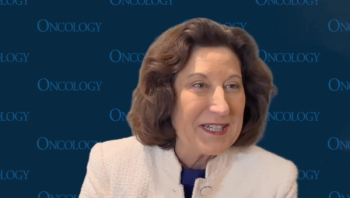
Fluorescence Guidance Meets Specificity Threshold in Breast Cancer
According to the investigators of the INSITE trial, the potential benefit of pegulicianine fluorescence–guided surgery in breast cancer warrants investigation in future studies.
Pegulicianine, a fluorescent imaging agent, met prespecified thresholds for the removal of residual tumors and specificity in patients with breast cancer when used to guide lumpectomy but did not reach a prespecified threshold for sensitivity, according to findings from the INSITE trial (NCT03686215).
For 7.6% (95% CI, 5.0%-10.8%) of patients undergoing pegulicianine fluorescence-guided surgery (pFGS), pFGS-guided margins removed tumor that remained following standard lumpectomy, including 22 from cavity orientations deemed negative in a standard margin evaluation. Nine of 22 patients with extracted residual tumor deposits in pFGS-guided margins had grade 3 histology and negative lumpectomy margins. Moreover, 15 of 22 patients had tumor deposits that were greater than 1 mm in size.
Margin-level specificity with pFGS was 85.2% (95% CI, 83.7%-86.6%), which exceeded the prespecified lower-bound goal of more than 60%. Additionally, the margin-level sensitivity was 49.3% (95% CI, 37.0%-61.6%), which failed to meet the prespecified lower-bound goal of more than 40%. The margin-level negative predictive and positive predictive values of pFGS, respectively, were 98.0% (95% CI, 97.7%-98.8%) and 9.2% (95% CI, 6.4%-12.6%).
“Our results showed that pFGS allowed real-time assessment of breast cancer lumpectomy cavity margins and facilitated removal of tumors left behind after standard lumpectomy surgery,” the study authors stated. “The system met prespecified goals for excision of residual tumor and for specificity, but it fell short of the goal for sensitivity. Although not a primary end point, pFGS had a negative predictive value of 98%, a critical attribute for a margin assessment tool.”
Investigators of the prospective, multi-center INSITE trial assessed patients across 14 treatment sites in the United States. All patients received 1.0 mg/kg of pegulicianine via 3-minute intravenous infusion 2 to 6 hours prior to surgery. To prevent surgeons from performing a lumpectomy that was smaller than standard in anticipation of assistance with pFGS, investigators randomly assigned patients 10:1 to the pFGS group or a control group in which patients did not receive pFGS. Notably, treatment randomization was not intended to provide a control group for analyzing device performance.
The co-primary end points of the trial included the percentage of patients for whom pFGS-guided margins contained cancer after standard lumpectomy, sensitivity, and specificity. Secondary end points included the positive margin rate following removal of pFGS-guided margins and the impact of pFGS margins on the volume of excised tissue.
Patients 18 years and older undergoing lumpectomy for stage I to III invasive breast cancer and/or ductal carcinoma in situ were eligible for enrollment on the trial. Patients who received neoadjuvant therapy or underwent margin re-excision after prior lumpectomy were not included.
The study included 406 patients who received pegulicianine. Additionally, of 392 patients who were randomly assigned, 35 were in the control group, and 357 were in the pFGS group.
Among patients who underwent randomization, the median age was 64 years (range, 36-83), 82.7% were White, and 94.4% were Non-Hispanic or Latino. Moreover, 80.6% had invasive cancer with or without ductal carcinoma in situ, and 19.4% had ductal carcinoma in situ alone. The median largest tumor dimension was 1.5 cm (range, 0.1-10.1).
Following lumpectomy and before imaging with pFGS, 17.4% of patients had at least 1 positive margin. Investigators were able to avoid second surgeries for 14.5% of patients by converting all positive margins to final negative margins in the initial lumpectomy. With pFGS, 27 patients had residual cancer removed, 9 were spared re-excision, and 1 was spared re-excision and had an additional tumor removed.
The mean tissue volume removed with standard lumpectomy was 74.9 cm3 among those who underwent pFGS. The mean tissue volume removed with standard lumpectomy in the control group was 82.0 cm3.
Investigators observed any-grade chromaturia in 90.1% of the overall population, which they attributed to the blue color of pegulicianine. Additionally, 1.5% of patients stopped receiving pegulicianine due to adverse effects (AEs), and 0.5% had serious grade 3 AEs related to pegulicianine, including 1 patient who had hypersensitivity and 1 other who had an anaphylactic reaction.
All AEs resolved, and patients were able to continue with scheduled lumpectomy. Investigators reported no deaths in this trial.
Reference
Smith BL, Hunt KK, Carr D, et al. Intraoperative fluorescence guidance for breast cancer lumpectomy surgery. NEJM Evidence. Published online April 27, 2023. doi:10.1056/EVIDoa2200333
Newsletter
Stay up to date on recent advances in the multidisciplinary approach to cancer.

















































































